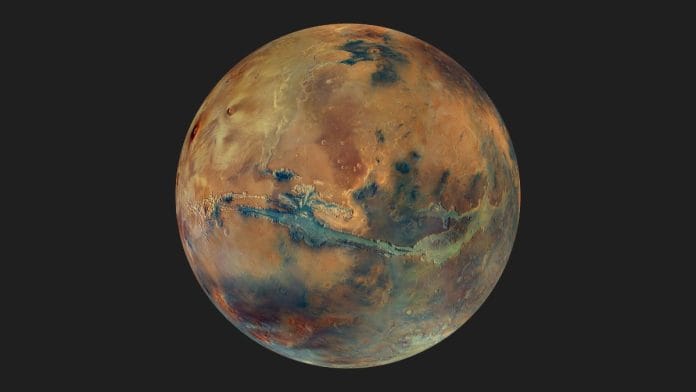Mohali: The rusty dust on the Red Planet is older than previously assumed and formed when volcanoes erupted, and water was widespread on its surface, a new study has found.
The study, led by Adomas Valantinas of Brown University in the United States, was published Tuesday in the journal Nature Communications. It was conducted combining novel laboratory experiments with data from spacecraft, including those from the European Space Agency (ESA) and National Aeronautics and Space Administration (NASA).
Mars is one of the easiest planets to spot in the night sky, thanks to its reddish hue. Observations by a fleet of spacecraft studying it from orbit, as well as from the ground in the last few decades, have confirmed that the colour of the Red Planet is attributed to rusted iron present in its dust.
This rust, chemically known as iron oxide, comes in different forms.
Earlier, the red colour of Mars was attributed to hematite—a form of rust that forms in desert-like dry conditions. It was believed that hematite formed on Mars due to reactions with its atmosphere after the early wet period ended. Over billions of years, rusty rocks were broken into fine dust, which was spread across the planet by fast-moving winds—a process that continues today.
Now, the new study reveals that Martian dust best matches a mixture of basalt (a volcanic rock), sulphites, and a different form of rust called ferrihydrite.
Ferrihydrite forms quickly in the presence of cool water, meaning it must have formed on Mars when its surface still hosted lakes, rivers, and seas filled with water.
That Mars rusted earlier than previously assumed—before its early wet period ended—has important implications for understanding its past and present climatic conditions, chemical history, and, ultimately, whether it was ever inhabited.
Also Read: Mars may have oceans’ worth of water underground, but this doesn’t mean it’s ready to be colonised
More about ferrihydrite
On Earth, ferrihydrite is usually found in volcanic caves and tephra—the material ejected during volcanic eruptions. The presence of ferrihydrites align with theories suggesting that Mars experienced a wet period with volcanic eruptions in the past.
At the end of this episode—estimated to be about three billion years ago—the volcanic matter interacted with surface water, resulting in the formation of ferrihydrites. Soon after, Mars transitioned into a cold, dry place, preserving its present form of iron oxide. The rusty rocks disintegrated into fine dust, which was dispersed all over the planet by high-speed winds and storms.
While other studies in the past have suggested the presence of ferrihydrites on Mars, Valantinas and colleagues provide the first concrete evidence to support this theory.
How the study was conducted
Researchers used an advanced grinder machine to create artificial Martian dust in the laboratory, with a turmeric-like ochre hue. The synthetic dust had a realistic particle size—about one-hundredth the width of human hair—consistent with the samples analysed by NASA’s Phoenix lander. The team tested mixtures of various minerals with different forms of iron oxide, including hematite and ferrihydrite. They then analysed the samples using the same techniques as an orbiting spacecraft to make a direct comparison with real Martian data.
Data from NASA’s Mars Reconnaissance Orbiter, together with measurements from the US space agency’s Curiosity, Pathfinder, and Opportunity rovers, helped confirm the presence of ferrihydrite.
The researchers are now eagerly awaiting results from upcoming missions such as the ESA’s Rosalind Franklin rover and the NASA-ESA Mars Sample Return mission, which will provide further insights into the composition of Martian soil.
Regolith samples already collected by NASA’s Perseverance rover include dust and will help scientists quantify the amount of ferrihydrite present once they are returned to Earth. Future studies will determine what the presence and quantity of ferrihydrite mean for our understanding of the history of water and the potential for life on Mars.
Until then, we continue to admire our red cousin from afar, pondering the origins of its striking hues.
(Edited by Radifah Kabir)
Also Read: Posture panic hits researchers. IITs, AIIMS, big hospitals use smart microscopes now






